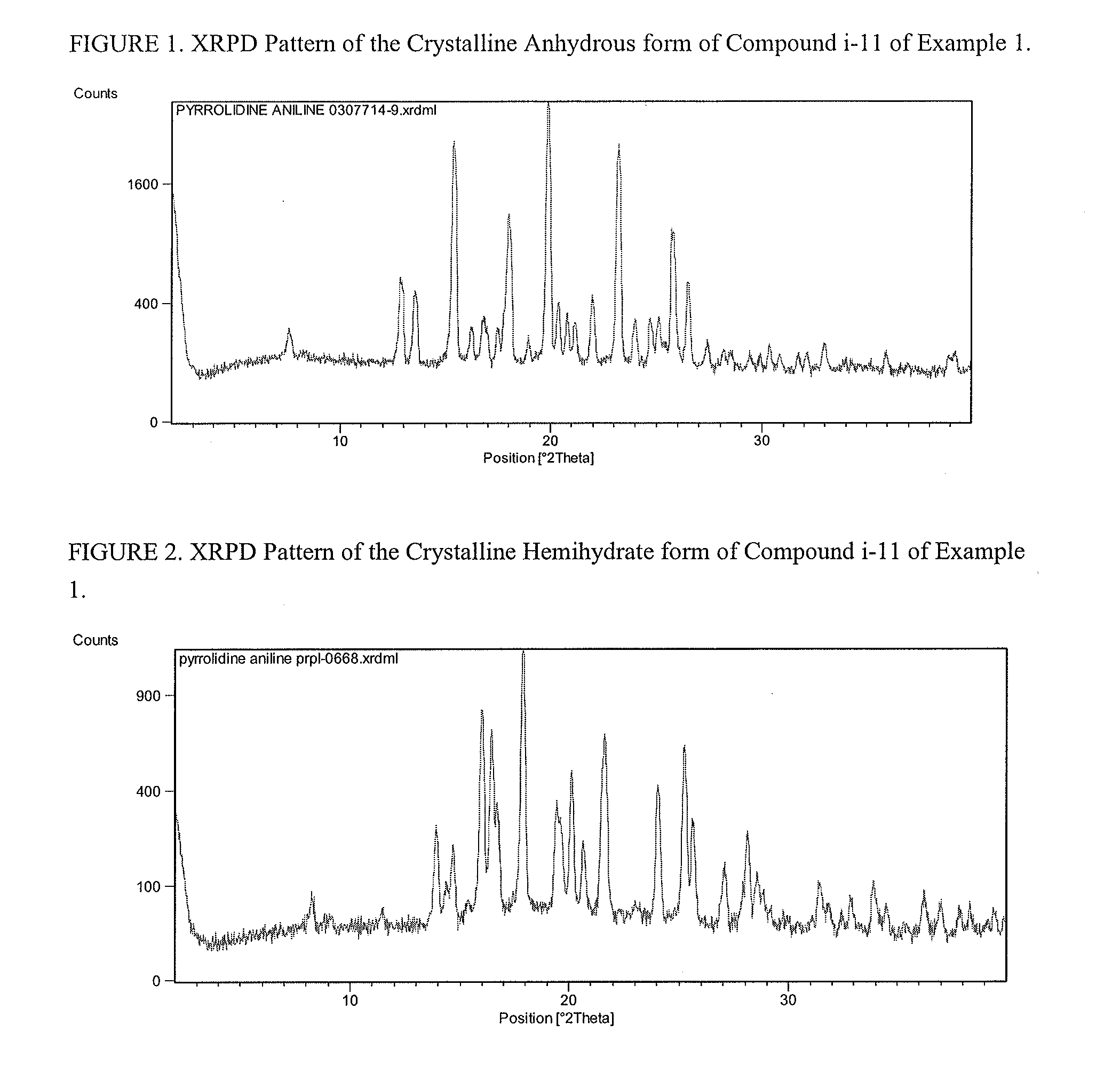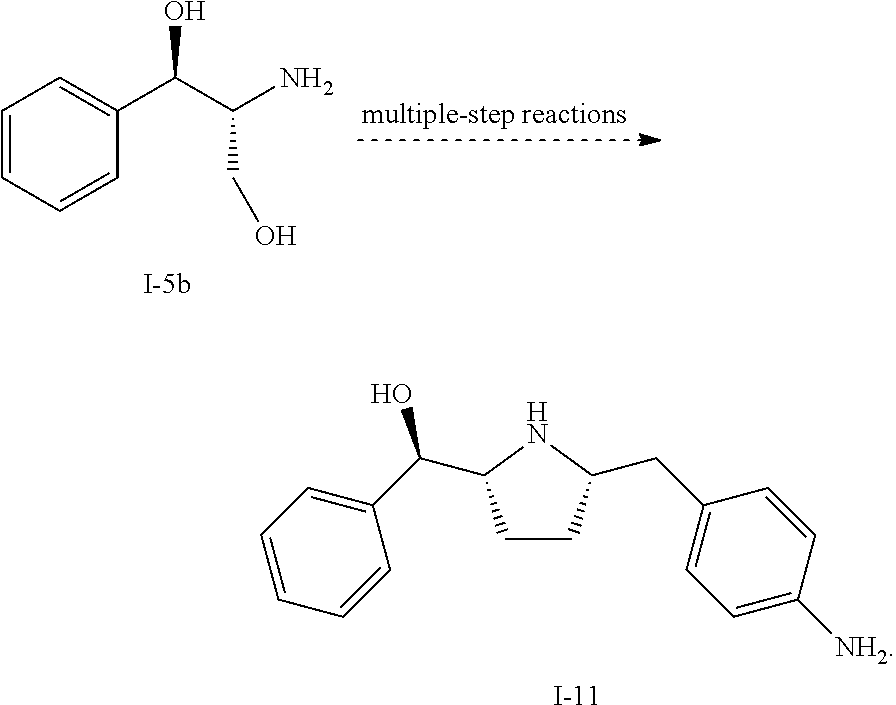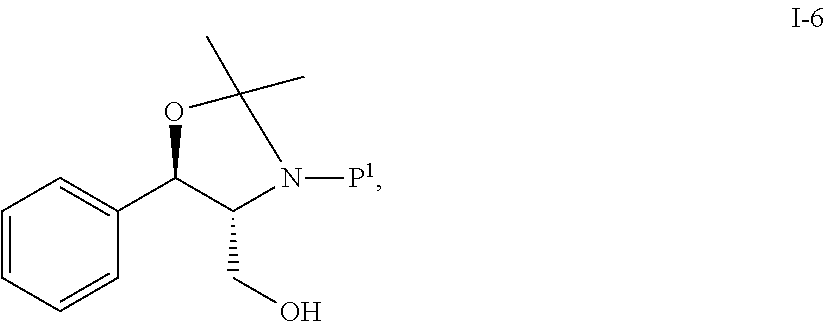Process for Making Beta 3 Agonists and Intermediates
a technology of beta 3 agonist and intermediates, applied in the direction of organic chemistry, organic active ingredients, drug compositions, etc., can solve the problems of negative impact on social and medical well-being, significant burden, and healthcare expenditures
- Summary
- Abstract
- Description
- Claims
- Application Information
AI Technical Summary
Benefits of technology
Problems solved by technology
Method used
Image
Examples
example 1
Preparation of Compound i-11 from Starting Compound I-5b
[0086]
[0087]In Scheme 1, starting material compound I-5b was converted to compound i-6 by reacting with acetone and Boc2O.
[0088]Once compound i-6 was obtained, it was converted to i-7 by TEMPO oxidation. For the TEMPO oxidation and subsequent HWE coupling step, a one-pot through process was used such that the crude steam of the aldehyde i-7 after phase cut was used directly for the HWE reaction to avoid solvent switch. Unsaturated ketone i-8 was isolated over 5 steps. Finally, compound i-8 was converted to compound i-11 through i-9 and i-10. Detailed experimental conditions are described below.
Step 1. Preparation of Acetonide-Boc Alcohol i-6 from I-5b
[0089]
[0090]To a flask equipped a Dean-Stark trap was charged (1R,2R)-(−)-2-amino-1-phenyl-1,3-propanediol (I-5b) (10 g, 58.6 mmol), acetone (12.0 ml), and toluene (40.0 ml) (or MTBE). The slurry was heated to reflux for 22 h. To the solution was added di-tert-butyl dicarbonate (14...
example 2
Process for Making Compound i-12 from Compound i-14 and Compound i-15
[0134]
Step 1. Preparation of 3-Aza-tricyclo[4.2.1.02,5]non-7-en-4-one (beta-Lactam) i-15 from i-18
[0135]
[0136]In a 100 L RBF fitted with an overhead stirrer, a thermocouple and a nitrogen inlet, was charged 36.8 L of DCM and 8.83 L of norbornadiene i-18. The solution was cooled to −15° C. A solution of 7.92 L of chlorosulfonylisocyanate in 11.2 L of DCM was added at a rate that keeps the internal temperature <5° C. The mixture was warmed to RT. After reaction was completed (by NMR), the reaction mixture was quenched into a 170 L cylinder vessel containing sodium sulfite (10.7 kg) in water (35.7 L) solution at a rate that keeps the internal temperature <15° C., maintaining a pH between 8.5 to 9.0 by addition of NaOH. Final pH was adjusted at 8.5.
[0137]Acetonitrile (24 L) was added and the layers were separated. If needed, 24 L of 20% brine solution was added to facilitate the viscous aqueous layer to flow. The top o...
example 3
Preparation of Compound of Formula (I) from Compound i-11 and Compound i-12
[0167]
[0168]To a three neck flask equipped with a N2 inlet, a thermo couple probe was charged pyrrolidine i-11 (10.0 g), sodium salt i-12 (7.87 g), followed by IPA (40 mL) and water (24 mL). 5 N HCl (14.9 mL) was then slowly added over a period of 20 min to adjust pH=3.3-3.5, maintaining the batch temperature below 35° C. Solid EDC hydrochloride (7.47 g) was charged in portions over 30 min. The reaction mixture was aged at RT for additional 0.5-1 h, aqueous ammonia (14%) was added dropwise to pH ˜8.6. The batch was seeded and aged for additional 1 h to form a slurry bed. The rest aqueous ammonia (14%, 53.2 ml total) was added dropwise over 6 h. The resulting thick slurry was aged 2-3 h before filtration. The wet-cake was displacement washed with 30% IPA (30 mL), followed by 15% IPA (2×20 mL) and water (2×20 mL). The cake was suction dried under N2 overnight to afford 14.3 g of compound of Formula (I).
[0169]1H...
PUM
| Property | Measurement | Unit |
|---|---|---|
| temperature | aaaaa | aaaaa |
| temperature | aaaaa | aaaaa |
| temperature | aaaaa | aaaaa |
Abstract
Description
Claims
Application Information
 Login to View More
Login to View More - R&D
- Intellectual Property
- Life Sciences
- Materials
- Tech Scout
- Unparalleled Data Quality
- Higher Quality Content
- 60% Fewer Hallucinations
Browse by: Latest US Patents, China's latest patents, Technical Efficacy Thesaurus, Application Domain, Technology Topic, Popular Technical Reports.
© 2025 PatSnap. All rights reserved.Legal|Privacy policy|Modern Slavery Act Transparency Statement|Sitemap|About US| Contact US: help@patsnap.com



